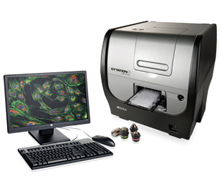Top R&D Tech of 2013

This year has been an awesome year for the lab instrumentation sector as far as new lab tech is concerned. At Labcritics we have been closely following manufacturers, researchers, service providers, startups, etc, closely to keep you updated on what’s happening and we can say it was a busy half a year. 2013 was also the year we began work on the Labcritics Marketplace aimed at digitally uniting manufacturers, distributors and their products in one place, there will be more on this one later.
All major lab instrumentation provider this year had some major announcements aimed at making research even faster, accurate, repeatable and even more enjoyable. Below are the top ten equipments that we picked after conducting various survey’s and interviews with researchers who either want one of these or already have purchased one.
We are rating the new lab equipments based on three factors: Innovation, Impact and Ease of Use. Innovation indicates the kind of leap that the new product has taken from its previous generation in terms of technology, speed, accuracy, etc. While Impact indicates the effect it will have on accelerating research and the number of diverse fields it will be useful in. Ease of use indicates the level of training needed to handle this equipment and its accompanying software.
Bruker maXis HD UHR-QTOF
7
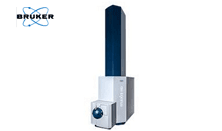 Bruker maXis HD UHR-QTOF (an upgrade to the Impact HD, released in June) is an ultra high performance mass spectrometry device designed to be used for a wide range of proteomics , metabolomics, food, forensic, environmental screening and biopharmaceutical applications. It features a novel HDC collision cell that offers a record breaking full sensitivity resolution greater than 75,000. Its 50 Gbit/sec sampling technology and highly sensitive mass transfer ion source lets Bruker maXis HD reach a dynamic range of 5 orders of magnitude in as less as 1 sec of LC time. In other words, it helps scientists identify complex and mixed compound/s in a record time. Read more about it here.
Bruker maXis HD UHR-QTOF (an upgrade to the Impact HD, released in June) is an ultra high performance mass spectrometry device designed to be used for a wide range of proteomics , metabolomics, food, forensic, environmental screening and biopharmaceutical applications. It features a novel HDC collision cell that offers a record breaking full sensitivity resolution greater than 75,000. Its 50 Gbit/sec sampling technology and highly sensitive mass transfer ion source lets Bruker maXis HD reach a dynamic range of 5 orders of magnitude in as less as 1 sec of LC time. In other words, it helps scientists identify complex and mixed compound/s in a record time. Read more about it here.
Agilent 7500 AFM
7
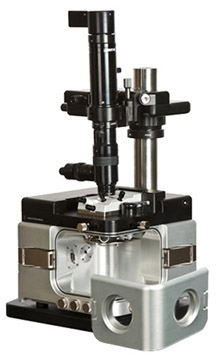 Agilent 7500 AFM is the latest addition to Agilent’s Atomic Force Microscopy range. This new equipment is designed for both academic and industrial use. The use of Agilent’s patented top-down tip scanner technology makes it capable of imaging samples in air, fluids and under controlled environments efficiently. Agilent 7500 AFM comes with an integrated environmental chamber fitted with sensors for imaging samples in controlled conditions. The equipment can be used in diverse modes such as contact, AAC, CS-AFM, EFM, KFM, MFM and MAC. Read more about it here.
Agilent 7500 AFM is the latest addition to Agilent’s Atomic Force Microscopy range. This new equipment is designed for both academic and industrial use. The use of Agilent’s patented top-down tip scanner technology makes it capable of imaging samples in air, fluids and under controlled environments efficiently. Agilent 7500 AFM comes with an integrated environmental chamber fitted with sensors for imaging samples in controlled conditions. The equipment can be used in diverse modes such as contact, AAC, CS-AFM, EFM, KFM, MFM and MAC. Read more about it here.
Leica SR GSD 3D Microscope
7
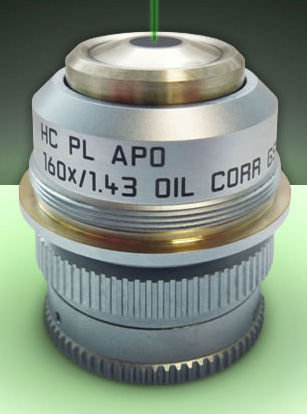 Leica SR GSD 3D Microscope is one among the many innovative products Leica Microsystems launched this year. This new wide-field fluorescence microscope offers superior 3D resolution imaging while allowing the users to localize signal molecules. The equipment has a fully automated Total Internal Reflection Fluorescence (TIRF) along with the GSD technology to achieve as less as 20 nm and 50 nm resolutions in lateral and axial directions respectively. The device has a 160x high performance objective, optimized for high energy lasers, low autofluorescence and color correction. It also is the only microscope that exploits the phenomenon of astigmatism to offer 3D imaging. Read more about it here.
Leica SR GSD 3D Microscope is one among the many innovative products Leica Microsystems launched this year. This new wide-field fluorescence microscope offers superior 3D resolution imaging while allowing the users to localize signal molecules. The equipment has a fully automated Total Internal Reflection Fluorescence (TIRF) along with the GSD technology to achieve as less as 20 nm and 50 nm resolutions in lateral and axial directions respectively. The device has a 160x high performance objective, optimized for high energy lasers, low autofluorescence and color correction. It also is the only microscope that exploits the phenomenon of astigmatism to offer 3D imaging. Read more about it here.
Tecnai Femto Ultrafast Electron Microscope
7
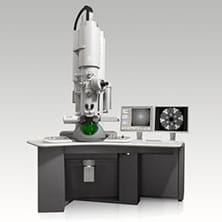 Tecnai Femto Ultrafast Electron Microscope is capable of capturing and investigating ultrafast events occurring in the time scale of femtoseconds. The equipment uses a patented Ultrafast Electronic Microscopy technology developed by Prof. Ahmed Zawail. It is a flexible instrument that can be used for observing the movements and structural changes occurring at atomic scale. Read more about it here.
Tecnai Femto Ultrafast Electron Microscope is capable of capturing and investigating ultrafast events occurring in the time scale of femtoseconds. The equipment uses a patented Ultrafast Electronic Microscopy technology developed by Prof. Ahmed Zawail. It is a flexible instrument that can be used for observing the movements and structural changes occurring at atomic scale. Read more about it here.
Zeiss Xradia 810 Ultra
8
 Zeiss Xradia Ultra 810 3D X-ray microscope is a high throughput equipment capable of producing images with great contrast and quality while using low energy X-ray of 5.4 keV for operation. Zeiss Xradia 810 Ultra is designed for Material Science, Life Science, Geology, Electronics and other applications. The Xradia 810 Ultra microscope is capable of achieving resolutions of 50 nm without even destroying the sample to provide synchrotron like results. Read more about it here.
Zeiss Xradia Ultra 810 3D X-ray microscope is a high throughput equipment capable of producing images with great contrast and quality while using low energy X-ray of 5.4 keV for operation. Zeiss Xradia 810 Ultra is designed for Material Science, Life Science, Geology, Electronics and other applications. The Xradia 810 Ultra microscope is capable of achieving resolutions of 50 nm without even destroying the sample to provide synchrotron like results. Read more about it here.
Nikon SMZ25 Research Stereomicroscope
8
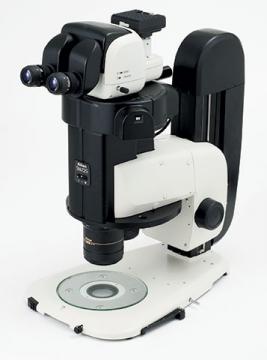 Launched earlier this year, Nikon SMZ25 microscope is equipped with Perfect Zoom Technology giving the world’s largest zoom ratio of 25:1. Nikon SMZ25 has automated zoom capability that provides high resolution and exceptional transmission capabilities to the device making it ideal for bioscience applications. It’s as easy to use as any other microscope from Nikon and costs around $25,000. Read more about it here.
Launched earlier this year, Nikon SMZ25 microscope is equipped with Perfect Zoom Technology giving the world’s largest zoom ratio of 25:1. Nikon SMZ25 has automated zoom capability that provides high resolution and exceptional transmission capabilities to the device making it ideal for bioscience applications. It’s as easy to use as any other microscope from Nikon and costs around $25,000. Read more about it here.
BioTek Cytation 3
The new Cytation 3 by BioTek Instruments is a hybrid multi mode microplate reader and imaging system with multi-detection and automated digital microscopy features bundled together in a single equipment. The patented Hybrid Technology in Cytation 3 uses both high sensitivity filter based and flexible quadruple monochromator based systems for microplate detection. The equipment measures absorbance, fluorescence and luminescence detection and can handle 6 to 384 well microplates and microscope slides. Cytation3 can be used for various applications like cell imaging and analysis, protein expression, cell proliferation studies, biomarker quantification etc. The product comes with a price tag of around $100,000. Read more about it here.
Thermo Scientific Orbitrap Fusion Tribrid
8
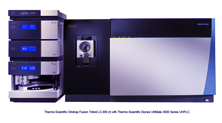 Orbitrap Fusion Tribrid is a Liquid Chromatography – Mass Spectrometry system launched earlier this year. Basically what Thermo Fisher has done here it that it has taken three of its best mass analyzers and shoved them all together. The tribrid architecture in Orbitrap Fusion is a combination of quadrupole, orbitrap and linear ion trap mass analyzers in a single platform, making it a high throughput and highly sensitive equipment that every research laboratory needs to have. Read more about it here.
Orbitrap Fusion Tribrid is a Liquid Chromatography – Mass Spectrometry system launched earlier this year. Basically what Thermo Fisher has done here it that it has taken three of its best mass analyzers and shoved them all together. The tribrid architecture in Orbitrap Fusion is a combination of quadrupole, orbitrap and linear ion trap mass analyzers in a single platform, making it a high throughput and highly sensitive equipment that every research laboratory needs to have. Read more about it here.
Nanofacture DNA recovery system
9
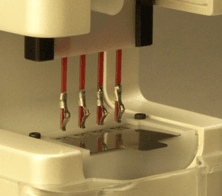 The Nanofacture DNA Recovery System is a novel device that can easily extract DNA from human biological fluids within minutes. It uses a proprietary technology developed in collaboration with the researchers at the University of Washington. Nanofacture DNA Recovery System uses a combination of electric field, chemical affinity and capillary action to extract DNA from samples. DNA extraction using this device doesn’t require any sample preparation kits or reagents and the time required for extraction is also very less, thus drastically reducing the time and resources needed for extracting DNA from human samples. It potential uses include research, forensic and even clinical laboratories. Read more about it here.
The Nanofacture DNA Recovery System is a novel device that can easily extract DNA from human biological fluids within minutes. It uses a proprietary technology developed in collaboration with the researchers at the University of Washington. Nanofacture DNA Recovery System uses a combination of electric field, chemical affinity and capillary action to extract DNA from samples. DNA extraction using this device doesn’t require any sample preparation kits or reagents and the time required for extraction is also very less, thus drastically reducing the time and resources needed for extracting DNA from human samples. It potential uses include research, forensic and even clinical laboratories. Read more about it here.
Waters ACQUITY QDA Detector
9
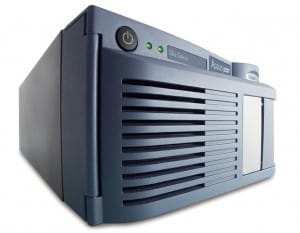
Last but not the least, the Waters ACQUITY QDa Detector provides chromatography systems with mass spectrometry capabilities for highly efficient sample analysis. The device incorporates 37 new patented/patent pending technologies to provide solutions to the complexity, cost and size issues that hindered the adoption of mass spectrometer for everyday usage until now. The ACQUITY QDa Detector automates sample analysis, eliminates the need for sample specific adjustments and makes it possible to obtain spectral data by just flipping a switch. This detector can complement the existing optical detectors to confirm the identity of compounds by using mass spectral information. It eliminates the need for running multiple additional assays or alternative techniques to confirm sample identity. Its small and is compatible with the company’s existing chromatography systems and costs around $40,000. Read more it here.
With rapid advancements in technology, we are looking forward to seeing lots of new equipments launching in 2014 that might succeed in making research more fun. On the non-lab instrumentation front, we have been particular interested in the use of 3D printing of organs, the outsourcing and automation of common and even complex lab experiments, among others. The huge scope of personalized medicine is helping pushing advancement in the next generation genome sequencing area and reducing the cloud computing costs, we might finally see sub $1,000 human genome sequencing. We have also been especially interested in the potential of crowdfunding to fund costly research and the move by many startups to bring research to everyone interested with DIY labs. Other movements we are personally excited about are the sudden popularity of open access research and the reproducability initiatives.
We are extremely excited to step into the new year on this positive note and hope that you too are as excited as we are. We wish you all the best and hope that we succeed in being useful to our readers and everyone else involved.







